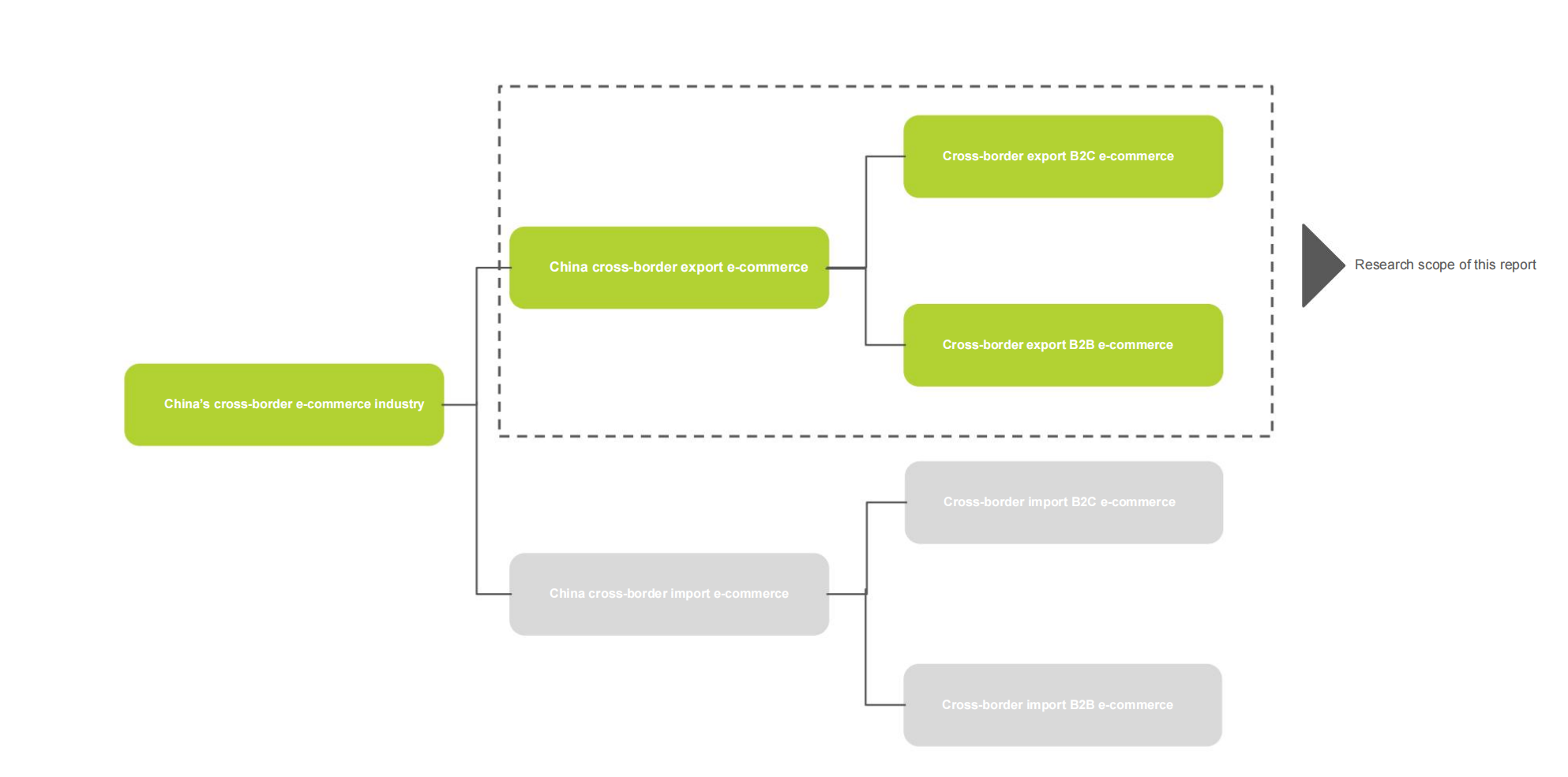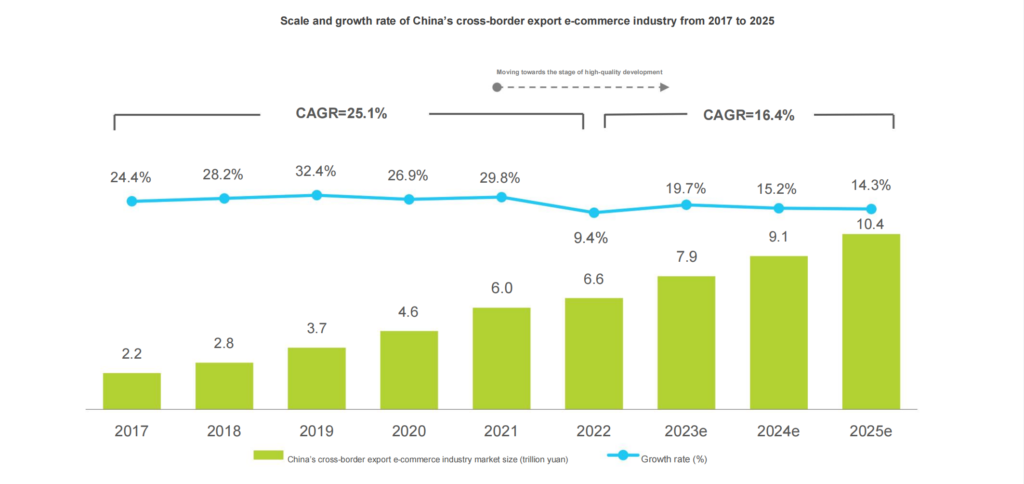Concepts and research areas
Cross-border export e-commerce
Cross-border export e-commerce concept: Through the e-commerce platform, export trade information display, customer communication and transaction processes are online to achieve cross-border sales and transaction business activities. It mainly includes B2C (cross-border export enterprises directly provide goods and services to individual consumers) and B2B (cross-border export enterprises conduct business-to-business commercial activities with overseas purchasing enterprises) models.

ABSTRACTS Summary
Cause
Global economic development has been under downward pressure in recent years. Import and export trade has been affected by multiple factors such as epidemic control, supply chain crises, geopolitical disputes, and regional protectionism. However, due to the high costs of anti-globalization, countries and regions around the world have The prospect of trading goods and services based on comparative advantages is still promising. At the same time, the restriction of offline channels during the epidemic has also accelerated the popularity of online transactions, further promoting the increase in the penetration rate of global e-commerce. With the upgrading of industrial structure, policy encouragement and technological progress, my country’s cross-border export e-commerce has ushered in new development opportunities.
Current situation
The industry has experienced an evolution from building information platforms, developing transaction services, improving service chains to ecological development. Currently, with the continuous improvement of compliance and supporting systems, the industry has officially entered a stage of high-quality development. Major platforms and service providers are increasing their efforts to integrate resources, improve the convenience of cross-border export business, and promote the healthy and orderly development of the industry. Despite being affected by multiple adverse factors, the cross-border export e-commerce industry still achieved a year-on-year positive growth of 9.4% in 2022, reaching a scale of 6.6 trillion yuan. It is expected that the industry will maintain a steady and progressive development trend in the future, with transaction scale It is also expected to usher in new breakthroughs.
Players
- -Platform side
The advantages of third-party and self operated platforms complement each other. The rising traffic cost of third-party platforms and the prevalence of emerging social media marketing are good for the development of self-operated platforms. Leading cross-border sellers with a certain user base generally prefer multi-channel layout.
- -Brand owners
From going overseas in the form of industry and trade integration to going overseas in the form of brand power, each brand owner continues to strengthen its digital capabilities, accelerate the integration of supply chains, and enhance brand influence.
- -Service providers
Service providers use their own capabilities to help cross-border enterprises complete and optimize their business chains. The close supply and demand relationship between external service providers and cross-border sellers accelerates the construction of the industry ecosystem and creates more value for the healthy development of the industry.
Category
- -Cross-border export B2C
The hot-selling categories are traditional export advantage products such as apparel and footwear, 3C electronics and home furnishings. Outdoor and beauty products will benefit from healthy living habits and spillover effects from the industrial chain and will also usher in new growth. In addition, maternal and infant, pet, wig and other categories will also show certain growth.
- -Cross-border export B2B
Backed by the advantages of manufacturing, tools and equipment, light industrial textiles and home products are at a high level and will remain stable in the short term. From a long-term perspective, based on comprehensive consideration of policy development orientation and industry structure change trends, new energy Auto parts and outdoor energy storage products are expected to become emerging potential categories and find new market opportunities in overseas regions with underdeveloped energy sources.
At the same time, both B2C and B2B export products are showing a branding trend. The increase in branding rate will not only drive the transformation of the industrial chain, but also help promote the profitability optimization and refined management capabilities of cross-border enterprises.
Region
- -Export location
China’s cross-border e-commerce industry clusters are mainly located in the southeastern coastal areas close to industrial belts and with high export activity, aiming to quickly respond to market demand through the “front store and back factory” model. At present, the country is actively establishing cross-border e-commerce comprehensive pilot zones around industrial clusters to promote regional resource integration and the construction of supporting facilities, provide a variety of services for cross-border sellers to “go global”, improve cross-border export efficiency, and help high-quality new foreign trade formats develop.
- -Destination
Mature markets such as Europe and the United States are still the main targets of Chinese cross-border sellers. With the implementation of relevant free trade agreements and the “Regional Comprehensive Economic Partnership Agreement” policies, emerging markets such as Southeast Asia, Latin America, and the Middle East have gradually become cross-border sellers. A new round of “nuggets”, my country’s trading partners tend to be diversified.
Trends
- -Diversification of cross-border platforms
Competition on the overseas track has become increasingly fierce, and the characteristics of diversified types of platform players and differentiated layouts have also begun to emerge , providing cross-border sellers with more channel choices.
- -Multi-channel layout for sellers
Affected by the tightening of platform compliance and the uncertainty of market policies, the seller group will tend to deploy multiple channels to spread risks. At the same time, offline and emerging media will also become the core channels that the seller group focuses on and plans to expand to deepen the
Localized service capabilities and expanded traffic portals.
- -Commodities drive service exports
Product branding and merchant multi-platform development have highlighted the importance of refined operations. Cross-border sellers ’ increased demand for various value-added services such as marketing, finance, and supply chain has directly promoted cross-border e-commerce. Serve the development of ecology.
- -Platform service chain extension
By combining internal and external strategies to improve the ecological layout, leading platforms will maintain this business strategy in the future and accelerate chain expansion. Emerging players will also follow the pace of leading players in ecological development as their business maturity increases. Optimize the layout and enhance competitiveness and monetization capabilities.
- -Deepening of cross-border services
The autonomy and resilience of my country’s cross-border services need to be further enhanced. The future path optimization direction will come from the construction or cooperation of overseas hardware facilities and key nodes on the one hand, and from the construction of overseas hardware facilities and key nodes on the other hand. In-depth insight into user needs and mature application of related technologies.
Full Report
For the full report, please click here to download.
(This report is taken from www.iresearch.com.cn and translated by Google, only for information-sharing purposes)

